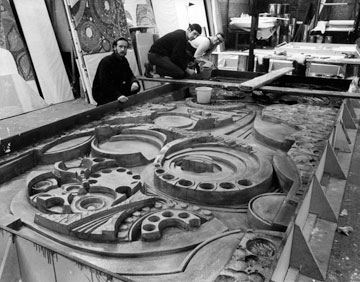Some Examples of Sculpture and Mural Work
The Savoy Centre - Sauchiehall St. Glasgow -

Structural concrete. c 1974. Client Rank Property Developments. London. Architect: Gavin Paterson & Sons. Glasgow. A great deal of insitu concrete relief sculpture was carried out in this building as well as cement render relief and areas of murals in synthetic resins. Carried out in c. 1972. Little of it is now visible since the shopping centre passed into new ownership and was revamped. However all of the structural concrete was apparently covered up with other cladding and should still be there.
Brandon St. Motherwell .

High level wall to raised amenity level. Size approx. 9 ft high and 300 ft long. Architect: Hugh Martin & Partners. This was done in precast concrete using polystyrene moulds. The piercings in each panel were part of the design, at the request of the structural engineers, to reduce weight. The sharpness of the detail in this technique is remarkable considering the delicacy of the mould material.
Charing Cross Station.

Wall opposite entrance.
Architect: Richard Seiffert & Partners. 1967
Entrance to Bell College of Technology, Hamilton.

Fibreglass relief mural -. Client Lanark County Council. Size approx. 9 ft high and 16 ft long. Architect: Local Authority.
Strathclyde School of Architecture Building.

In-situ concrete wall sculpture for Client - Strathclyde University. Architect: Prof. Frank Fielden & Assoc. 1965.
Livingston New Town .

The most prestigious commission to date (and last public commission undertaken) was the result of winning a national sculpture competition to provide a bronze figurative group (which is entitled "The Community" ) for Livingston New Town in 1996.
|
The Thomson Sports Centre - Burnley Lancs.

Precast concrete panels. Architect: Local Authority. Size approx. 9 ft high, 150 ft long. Client Burnley Borough Council . c 1973.
Bellahouston Sports Centre. Glasgow.

Incised cement render relief. approx. 35 ft high and 60 ft long. Client: Glasgow Corporation (as it was known then). c. 1967.
Offices of the Inland Revenue, Cumberbauld

Two piece three dimensional sculpture - insitu concrete for the Offices of the Inland Revenue, Cumbernauld.
New County Buildings Paisley.

In the Studio/Workshop. Moulds for fibreglass relief mural for Size approx. Architect: Hutcheson, Locke & Monk Architects.
Scottish Amicable Life Assurance.

Fibreglass sculpture for the Scottish Amicable Headquarters building at Craigforth in Stirling - a cold cast bronze sculpture almost 16 metres (53 ft) high. Architects: William Nimmo & Partners. Glasgow. c 1989 |